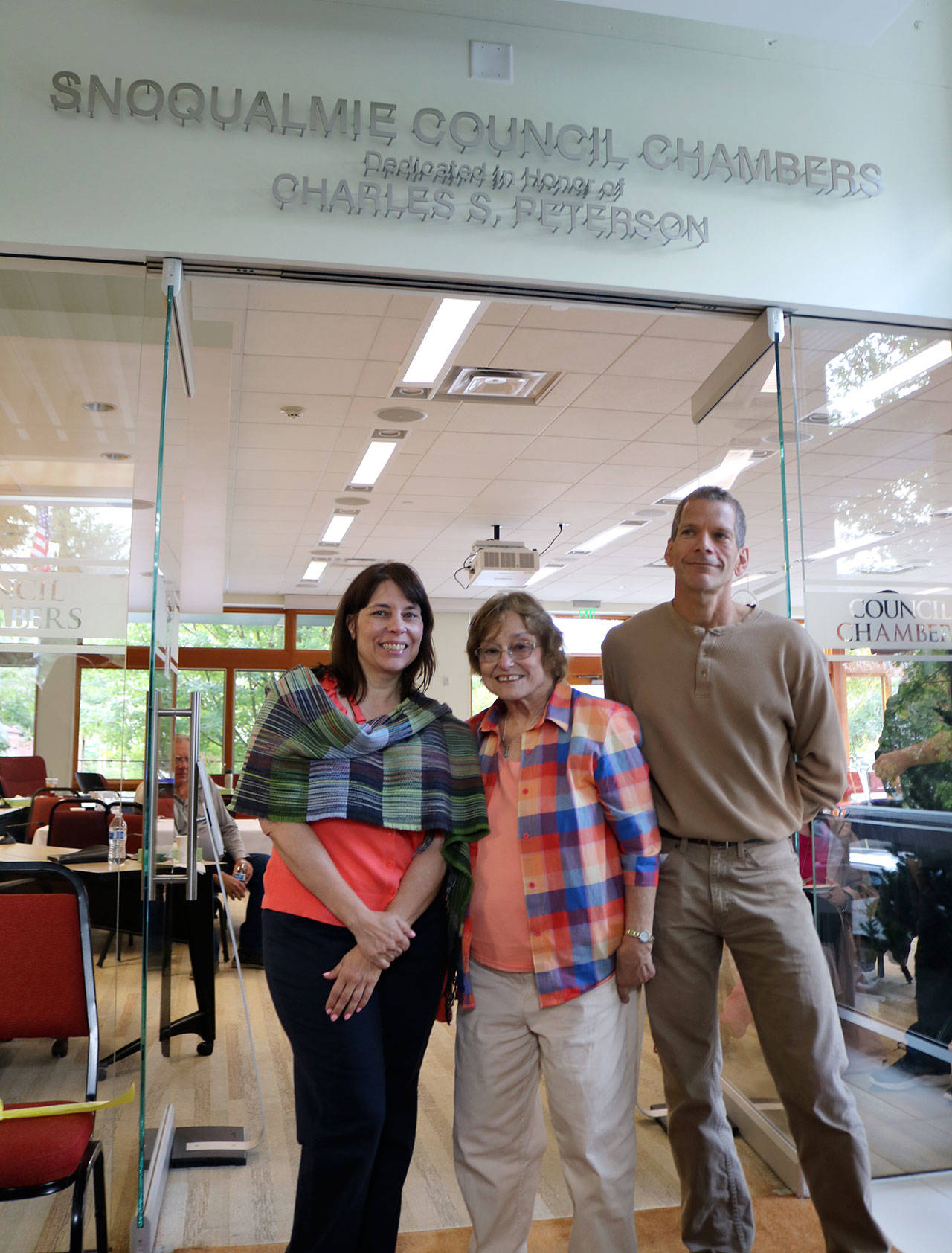After months of preparation and work, the family of former city leader Charles S. Peterson held a community walk to several downtown Snoqualmie locations and announced the dedication of several memorials in memory of Peterson, who died in April.
At 2 p.m. on Sunday, Oct. 1, more than 60 people joined Carol Peterson and her children, Julie and Ryan, at Snoqualmie United Methodist Church to begin the tour. The first memorial dedicated to Peterson was a new sign for the church, an Eagle Scout project spearheaded by Will Huestis of Boy Scout Troop 466.
The current sign, been in use for more than 40 years, is breaking down. The sign leans over on its front, and the wooden border has been chipped away through years of rain, snow and wind. The new sign, created by a church sign company in Florida, will arrive in Snoqualmie in a few weeks and will have a plaque on the back, detailing Peterson’s involvement and influence on the church.
Huestis said that both Charles and Carol had helped the new sign project get off the ground. The sign was funded by the Charles Peterson Memorial Fund with money from the Peterson family.
“Charles was really the initial push who got it into action,” Huestis said. “When Charles passed, there was funding that provided specifically for the sign because he had an interest in that.”
From the church, the group walked over to the historic Mignone Interiors building, currently home to Sigillo Cellars. Two plaques were put up on the front of the building to dedicate the siren that sits atop the building, and the building itself to Peterson.
Lee Briggs and Dean Martin, retired Snoqualmie firefighters, and Snoqualmie historian Dave Battey spoke about the history of the siren and its use in Snoqualmie.
The siren hadn’t been in use for almost a year, because of an internal clock error, but it was recently repaired. With the sounding of the alarm at the day’s event, the siren returned to its daily schedule, sounding at noon.
The building itself is one of Snoqualmie’s oldest, with a past as a silent movie theater and a combined town hall and fire hall. From the 1940s to 2005, the building was the home to the union hall for the lumber and sawmill Weyerhaeuser employees. As a union official for decades, Peterson was very involved in the union hall and even helped to move the furniture out to another community organization when the hall shut down in 2005.
“About that time the Meadowbrook Farm Interpretive Center opened with no furniture, Charles called and said ‘can you use some tables and chairs from the union hall?’ So the very first furniture in the union hall was due to Charles and the union,” Battey said.
After sounding the siren, the group walked to the Peterson house on Maple Avenue SE, where Carol Peterson had plaques installed detailing the history of their historic home. Also on display were Charles’ Father’s 48-star flag and a memorial garden that Carol had created.
Carol explained the history of the house, which had been home to only two families, the Petersons and Amy and William English, who were once the town pharmacists. Carol said that Amy English had been the city’s first woman mayor. After Charles had served as Mayor, the house was nicknamed “The Mayor’s House,” by another former mayor, Jeanne Hansen.
Carol also spoke about the garden she put together in memory of Charles and, together with her children, the family spread some of Charles’ ashes onto the garden.
The group then headed to Snoqualmie City Hall for the final stop on the tour.
At City Hall, Carol Peterson, Snoqualmie Mayor Matt Larson and Snoqualmie Councilmen Bob Jeans and Bryan Holloway spoke about Charles’ impact on the community through his work on the planning commission, as a city council member and as the mayor for two terms.
Holloway said Charles was instrumental in the preservation of what is now the Meadowbrook Farm. He protected the property from residential or commercial development in the 1970s, and worked with the county to change the zoning of the farm to rural as it was annexed into Snoqualmie and North Bend.
Finally, the city unveiled the new lettering above the doorway to the council chambers, dedicating the room to Charles S. Peterson.
“One of the last things he said to me before he died was he didn’t want his name in a park or on a street, he wanted his name somehow on the city council chambers because even though he had been Mayor and on the planning commission for year and years, legislative was really his game,” Carol said.
“He liked being on the legislative end of the city government and the council chambers are what he felt was really home to him.”


